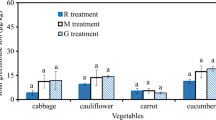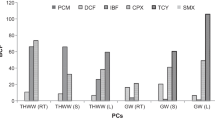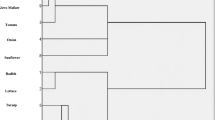Abstract
The use of reclaimed water in agriculture is an effective way to alleviate water scarcity. However, reclaimed water often contains pharmaceutical and personal care products (PPCPs), which might be introduced into agricultural soil and crops through reclaimed water irrigation. In this study, a field experiment was conducted to investigate the concentrations of PPCPs in the soil-cereal system after reclaimed water irrigation in 2015 and 2016 in the North China Plain. Three different water qualities were used for summer maize and winter wheat: reclaimed water, mixed water (reclaimed water and groundwater, 1:1), and groundwater. The total concentration of 11 PPCPs in winter wheat grain, summer maize grain and the topsoil (0–20 cm depth) was 1.37–7.65, 4.33–5.07, and 5.85–13.7 μg/kg, respectively. And the total bioaccumulation factors (BCFs) of the 11 PPCPs for summer maize and winter wheat were 3.40–5.23 and 0.11–0.21, respectively. There were no significant differences in the PPCP concentrations in the topsoil-cereal system or in the BCFs among the three irrigation treatments. The total hazard quotients for the 11 PPCPs were 0.019 and 0.053 for adults and toddlers, respectively, suggesting that consumption of the cereal grains in the current research (irrigation with groundwater, mixed water, or reclaimed water) presented little risk to human health.





Similar content being viewed by others
Data availability
The datasets generated during and/or analysed during the current study are available upon request from the corresponding author.
References
Ahmed MBM, Rajapaksha AU, Lim JE, Vu NT, Kim IS, Kang HM, Lee SS, Ok YS (2015) Distribution and accumulative pattern of tetracyclines and sulfonamides in edible vegetables of cucumber, tomato, and lettuce. J Agric Food Chem 63:398–405. https://doi.org/10.1021/jf5034637
Al-Farsi R, Ahmed M, Al-Busaidi A, Choudri BS (2018) Assessing the presence of pharmaceuticals in soil and plants irrigated with treated wastewater in Oman. Int J Recyc Org Waste Agri 7:165–172. https://doi.org/10.1007/s40093-018-0202-1
Bhalsod GD, Chuang YH, Jeon S, Gui WJ, Li H, Ryser ET, Guber AK, Zhang W (2018) Uptake and accumulation of pharmaceuticals in overhead and surface irrigated greenhouse lettuce. J Agric Food Chem 66:822–830. https://doi.org/10.1021/acs.jafc.7b04355
Biel-Maeso M, Corada-Fernández C, Lara-Martín PA (2018) Monitoring the occurrence of pharmaceuticals in soils irrigated with reclaimed wastewater. Environ Pollut 235:312–321. https://doi.org/10.1016/j.envpol.2017.12.085
Bigott Y, Gallego S, Montemurro N, Breuil MC, Pérez S, Michas A, Martin-Laurent F, Schröder P (2022) Fate and impact of wastewater-borne micropollutants in lettuce and the root-associated bacteria. Sci Total Environ 831:154674. https://doi.org/10.1016/j.scitotenv.2022.154674
Boxall ABA, Rudd MA, Brooks BW, Caldwell DJ, Choi K, Hickmann S, Innes E, Ostapyk K, Staveley JP, Verslycke T, Ankley GT, Beazley KF, Belanger SE, Berninger JP, Carriquiriborde P, Coors A, DeLeo PC, Dyer SD, Ericson JF, Gagné F, Giesy JP, Gouin T, Hallstrom L, Karlsson MV, Larsson DGJ, Lazorchak JM, Mastrocco F, McLaughlin A, McMaster ME, Meyerhoff RD, Moore R, Parrott JL, Snape JR, Murray-Smith R, Servos MR, Sibley PK, Straub JO, Szabo ND, Topp E, Tetreault GR, Trudeau VL, Kraak GVD (2012) Pharmaceuticals and personal care products in the environment: what are the big questions? Environ Health Perspect 120:1221–1229. https://doi.org/10.1289/ehp.1104477
Briggs GG, Bromilow RH, Evans AA (1982) Relationships between lipophilicity and root uptake and translocation of non-ionised chemicals by Barley. Pestic Sci 13:495–504
Carter LJ, Harris E, Williams M, Ryan JJ, Kookana RS, Boxall ABA (2014) Fate and uptake of pharmaceuticals in soil-plant systems. J Agr Food Chem 62(4):816–825. https://doi.org/10.1021/jf404282y
Chen K, Zhou JL (2014) Occurrence and behavior of antibiotics in water and sediments from the Huangpu River, Shanghai. China Chemosph 95:604–612. https://doi.org/10.1016/j.chemosphere.2013.09.119
Chen M, Yi Q, Hong J, Zhang L, Lin K, Yuan D (2015) Simultaneous determination of 32 antibiotics and 12 pesticides in sediment using ultrasonic-assisted extraction and high performance liquid chromatography-tandem mass spectrometry. Anal Meth 7:1896–1905. https://doi.org/10.1039/C4AY02895C
Christou A, Karaolia P, Hapeshi E, Michael C, Fatta-Kassinos D (2017) Long-term wastewater irrigation of vegetables in real agricultural systems: concentration of pharmaceuticals in soil, uptake and bioaccumulation in tomato fruits and human health risk assessment. Water Res 109:24–34. https://doi.org/10.1016/j.watres.2016.11.033
Dodgen LK, Ueda A, Wu XQ, Parker DR, Gan J (2015) Effect of transpiration on plant accumulation and translocation of PPCP/EDCs. Environ Pollut 198:144–153. https://doi.org/10.1016/j.envpol.2015.01.002
Dudley S, Sun CL, Jiang J, Gan J (2018) Metabolism of sulfamethoxazole in Arabidopsis thaliana cells and cucumber seedlings. Environ Pollut 242:1748–1757. https://doi.org/10.1016/j.envpol.2018.07.094
Food and Agriculture Organization of the United Nations, 2011. Residues of some veterinary drugs in foods and animals. Food and Agriculture Organization of the United Nations, Rome, Italy.
Franklin AM, Williams CF, Andrews DM, Woodward EE, Watson JE (2016) Uptake of three antibiotics and an antiepileptic drug by wheat crops spray irrigated with wastewater treatment plant effluent. J Environ Qual 45:546–554. https://doi.org/10.2134/jeq2015.05.0257
Gao LH, Shi YL, Li WH, Liu JM, Cai YQ (2015) Occurrence and distribution of antibiotics in urban soil in Beijing and Shanghai. China Environ Sci Pollut r 22:11360–11371. https://doi.org/10.1007/s11356-015-4230-3
García-Galán MJ, Díaz-Cruz S, Barceló D (2013) Multiresidue trace analysis of sulfonamide antibiotics and their metabolites in soils and sewage sludge by pressurized liquid extraction followed by liquid chromatography-electrospray-quadrupole linear ion trap mass spectrometry. J Chromatogr A 1275:32–40. https://doi.org/10.1016/j.chroma.2012.12.004
GB 20922–2007, 2007. The reuse of urban recycling water quality of farmland irrigation water. Beijing: Standards Press of China.
GB5084–2005, 2005. Standards for irrigation water quality. Beijing: Standards Press of China.
Goldstein M, Shenker M, Chefetz B (2014) Insights into the uptake processes of wastewater-borne pharmaceuticals by vegetables. Environ Sci Technol 48(10):5593–5600. https://doi.org/10.1021/es5008615
Gottschall N, Topp E, Metcalfe C, Edwards M, Payne M, Kleywegt S, Russell P, Lapen DR (2012) Pharmaceutical and personal care products in groundwater, subsurface drainage, soil, and wheat grain, following a high single application of municipal biosolids to a field. Chemosphere 87:194–203. https://doi.org/10.1016/j.chemosphere.2011.12.018
Hanna N, Sun P, Sun Q, Li XW, Yang XW, Ji X, Zou HY, Ottoson J, Nilsson LE, Berglund B, Dyar OJ, Tamhankar AJ, Lundborg CS (2018) Presence of antibiotic residues in various environmental compartments of Shandong Province in eastern China: its potential for resistance development and ecological and human risk. Environ Int 114:131–142. https://doi.org/10.1016/j.envint.2018.02.003
Hu YQ, Wu WY (2018) Review and development strategy of irrigation with unconventional water resources in China. Strat Study CAE 20(5):69–76 (in Chinese with English abstract)
Hu SQ, Zhang Y, Shen GX, Zhang HC, Yuan ZJ, Zhang W (2019) Adsorption/desorption behavior and mechanisms of sulfadiazine and sulfamethoxazole in agricultural soil systems. Soil till Res 186:233–241. https://doi.org/10.1016/j.still.2018.10.026
ICID (international commission of irrigation and drainage), 2017. A Road Map to ICID Vision 2030-A Water Secure World Free of Poverty and Hunger. Indian.
Jin CX, Wei S, Sun RL, Zou W, Zhang XL, Zhou QX, Liu R, Huang LQ (2020) The forms, distribution, and risk assessment of sulfonamide antibiotics in the manure-soil-vegetable system of feedlot livestock. B Environ Contam Tox 105:790–797. https://doi.org/10.1007/s00128-020-03010-9
Koba O, Golovko O, Kodesova R, Fer M, Grabic R (2017) Antibiotics degradation in soil: a case of clindamycin, trimethoprim, sulfamethoxazole and their transformation products. Environ Pollut 220:1251–1263. https://doi.org/10.1016/j.envpol.2016.11.007
Kodešová R, Kočárek M, Klement A, Golovko O, Koba O, Fér M, Nikodem A, Vondráčková L, Jakšík O, Grabic R (2016) An analysis of the dissipation of pharmaceuticals under thirteen different soil conditions. Sci Total Environ 544:369–381. https://doi.org/10.1016/j.scitotenv.2015.11.085
Li Y, Huang GH, Gu H, Huang QZ, Lou CH, Zhang L, Liu HL (2018) Assessing the risk of phthalate ester (PAE) contamination in soils and crops irrigated with treated sewage effluent. Water 10(8):999. https://doi.org/10.3390/w10080999
Liu XJ, Liang CZ, Liu XH, Zhao F, Han C (2020) Occurrence and human health risk assessment of pharmaceuticals and personal care products in real agricultural systems with long-term reclaimed wastewater irrigation in Beijing China. Ecotox Environ Safe 190:110022. https://doi.org/10.1016/j.ecoenv.2019.110022
Malchi T, Maor Y, Tadmor G, Shenker M, Chefetz B (2014) Irrigation of root vegetables with treated wastewater: evaluating uptake of pharmaceuticals and the associated human health risks. Environ Sci Technol 48:9325–9333. https://doi.org/10.1021/es5017894
Manasfi R, Brienza M, Ait-Mouheb N, Montemurro N, Perez S, Chiron S (2021) Impact of long-term irrigation with municipal reclaimed wastewater on the uptake and degradation of organic contaminants in lettuce and leek. Sci Total Environ 765:142742. https://doi.org/10.1016/j.scitotenv.2020.142742
Meffe R, Santiage Martín AD, Teijón G, Hernández VM, López-Heras I, Nozal L, Bustamante ID (2021) Pharmaceutical and transformation products during unplanned water reuse: insights into natural attenuation, plant uptake and human health impact under field conditions. Environ Int 157:106835. https://doi.org/10.1016/j.envint.2021.106835
Mordechay EB, Mordehay V, Tarchitzky J, Chefetz B (2021) Pharmaceuticals in edible crops irrigated with reclaimed wastewater: evidence from a large survey in Israel. J Hazard Mater 416:126184. https://doi.org/10.1016/j.jhazmat.2021.126184
Pan M, Chu LM (2016) Adsorption and degradation of five selected antibiotics in agricultural soil. Sci Total Environ 545–546:48–56. https://doi.org/10.1016/j.scitotenv.201512.040
Pan M, Chu LM (2017a) Transfer of antibiotics from wastewater or animal manure to soil and edible crops. Environ Pollut 231:829–836. https://doi.org/10.1016/j.envpol.2017.08.051
Pan M, Chu LM (2017b) Fate of antibiotics in soil and their uptake by edible crops. Sci Total Environ 599–600:500–512. https://doi.org/10.1016/j.scitotenv.2017.04.214
Pan M, Wong CKC, Chu LM (2014) Distribution of antibiotics in wastewater-irrigated soils and their accumulation in vegetable crops in the Pearl River Delta. Southern China J Agr Food Chem 62:11062–11069. https://doi.org/10.1021/jf503850v
Papaioannou D, Koukoulakis PH, Papageorgiou M, Lambropoulou DA, Kalavrouziotis IK (2020) Investigation of pharmaceutical and personal care product interactions of soil and beets (Beta vulgaris L.) under the effect of wastewater reuse. Chemosphere 238:124553. https://doi.org/10.1016/j.chemosphere.2019.124553
Patel M, Kumar R, Kishor K, Mlsna T, Pittman CU Jr, Mohan D (2019) Pharmaceuticals of emerging concern in aquatic systems: chemistry, occurrence, effects, and removal methods. Chem Rev 199:3510–3673. https://doi.org/10.1021/acs.chemrev.8b00299
Prosser RS, Sibley PK (2015) Human health risk assessment of pharmaceuticals and personal care products in plant tissue due to biosolids and manure amendments, and wastewater irrigation. Environ Int 75:223–233. https://doi.org/10.1016/j.envint.2014.11.020
Santiago-Martín AD, Meffe R, Teijón G, Hernández VM, López-Heras I, Alonso CA, Romasanta MA, Bustamante ID (2020) Pharmaceuticals and trace metals in the surface water used for crop irrigation: risk to health or natural attenuation? Sci Total Environ 705:135825. https://doi.org/10.1016/j.scitotenv.2019.135825
Sengar A, Vijayanandan A (2022) Human health and ecological risk assessment of 98 pharmaceuticals and personal care products (PPCPs) detected in Indian surface and wastewaters. Sci Total Environ 807:150677. https://doi.org/10.1016/j.scitotenv.2021.150677
Shelver WL, Hakk H, Larsen GL, DeSutter TM, Casey FXM (2010) Development of an ultra-high-pressure liquid chromatography-tandem mass spectrometry multi-residue sulfonamide method and its application to water, manure slurry, and soils from swine rearing facilities. J Chromatogr A 1217:1273–1282. https://doi.org/10.1016/j.chroma.2009.12.034
Sun CL, Dudley S, Trumble J, Gan J (2018) Pharmaceutical and personal care products-induced stress symptoms and detoxification mechanisms in cucumber plants. Environ Pollut 234:39–47. https://doi.org/10.1016/j.envpol.2017.11.041
Sunyer-Caldú A, Diaz-Cruz MS (2021) Development of a QuEChERS-based method for the analysis of pharmaceuticals and personal care products in lettuces grown in field-scale agricultural plots irrigated with reclaimed water. Talanta 230:122302. https://doi.org/10.1016/j.talanta.2021.122302
Tanoue RM, Sato YR, Motoyama MK, Nakagawa SH, Shinohara R, Nomiyama K (2012) Plant uptake of pharmaceutical chemicals detected in recycled organic manure and reclaimed wastewater. J Agr Food Chem 60:10203–10211. https://doi.org/10.1021/jf303142t
Trapp S (2004) Plant uptake and transport models for neutral and ionic chemicals. Environ Sci Pollut Res 11(1):33–39. https://doi.org/10.1065/espr2003.08.169
Trapp S (2009) Bioaccumulation of polar and ionizable compounds in plants. In: Devillers J (ed) Ecotoxicology Modeling. Springer, New York, pp 299–353
Wu XQ, Ernst F, Conkle JL, Gan J (2013) Comparative uptake and translocation of pharmaceutical and personal care products (PPCPs) by common vegetables. Environ Int 60:15–22. https://doi.org/10.1016/j.envint.2013.07.015
Xu YB, Yu XQ, Xu BL, Peng D, Guo XT (2021) Sorption of pharmaceuticals and personal care products on soil and soil components: influencing factors and mechanisms. Sci Total Environ 753:141891. https://doi.org/10.1016/j.scitotenv.2020.141891
Yuan SF, Liu ZH, Yin H, Dang Z, Wu PX, Zhu NW, Lin Z (2019) Trace determination of sulfonamide antibiotics and their acetylated metabolites via SPE-LC-MS/MS in wastewater and insights from their occurrence in a municipal wastewater treatment plant. Sci Total Environ 653:815–821. https://doi.org/10.1016/j.scitotenv.2018.10.417
Ziylan-Yavas A, Santos D, Flores EMM, Ince NH (2022) Pharmaceuticals and personal care products (PPCPs): environmental and public health risks. Environ Prog Sustain Energy 41(4):e13821. https://doi.org/10.1002/ep.13821
Acknowledgements
People in the Beijing Irrigation Test Center Station have given us a lot of help during the experimental time, we are very grateful to them for their help.
Funding
This research was supported by the Natural Science Foundation of Jiangsu Province, China (BK20200941; BK20200955), the Green Yang Jinfeng project (YZLYJF2020PHD070), construction of safe utilization technology system of reclaimed water in Beijing, and National Natural Science Foundation of China (52009117).
Author information
Authors and Affiliations
Contributions
The experiments were designed by HL, the experiments were performed by HF and BL, the data was analyzed by WX, the paper was written by YL and JW.
Corresponding author
Ethics declarations
Conflict of interest
There was no conflict of interest among the authors.
Ethical approval
Not applicable.
Consent to publish and participate
All the authors listed have approved the manuscript that is enclosed. The manuscript is approved by all authors for publication.
Additional information
Publisher's Note
Springer Nature remains neutral with regard to jurisdictional claims in published maps and institutional affiliations.
Supplementary Information
Below is the link to the electronic supplementary material.
Rights and permissions
Springer Nature or its licensor (e.g. a society or other partner) holds exclusive rights to this article under a publishing agreement with the author(s) or other rightsholder(s); author self-archiving of the accepted manuscript version of this article is solely governed by the terms of such publishing agreement and applicable law.
About this article
Cite this article
Li, Y., Liu, H., Wang, J. et al. Impacts of reclaimed water irrigation on the accumulation of pharmaceutical and personal care products in soil and cereals. Irrig Sci 42, 419–430 (2024). https://doi.org/10.1007/s00271-023-00868-5
Received:
Accepted:
Published:
Issue Date:
DOI: https://doi.org/10.1007/s00271-023-00868-5




